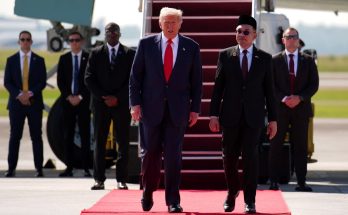 India’s relief, if not joy, over the outcome of the Sri Lankan elections that saw the exit of Mahinda Rajpakse is barely concealed. In recent years, there was a sense in New Delhi that Sri Lanka was slipping out of Indian hands. But before the celebrations get too rowdy, we should be aware that the foreign policy of a mature democracy like Sri Lanka is not made by individuals, but is based on interests. We should make no assumptions about the manner in which the incoming Maithripala Sirisena government will deal with areas of our concerns – the treatment of the Tamil minority and the growing Chinese influence in the island.
India’s relief, if not joy, over the outcome of the Sri Lankan elections that saw the exit of Mahinda Rajpakse is barely concealed. In recent years, there was a sense in New Delhi that Sri Lanka was slipping out of Indian hands. But before the celebrations get too rowdy, we should be aware that the foreign policy of a mature democracy like Sri Lanka is not made by individuals, but is based on interests. We should make no assumptions about the manner in which the incoming Maithripala Sirisena government will deal with areas of our concerns – the treatment of the Tamil minority and the growing Chinese influence in the island.
Emergence
India’s refusal to intervene in the civil war which pitted the Liberation Tigers of Tamil Eelam (LTTE) versus the Sri Lankan Army, more or less decided the issue in favour of the latter.
Rajiv Gandhi’s assassination and the loss of over 1,000 Indian Army personnel in the 1987-1990 period ensured that India would remain out of the Sri Lankan equations till the LTTE was obliterated.
The Sri Lankan victory over the Tigers in May 2009 had many consequences, none of them good for India. The land was devastated and the Sri Lankan Tamils, India’s “natural allies” left leaderless and disempowered.
Second, the Rajpakse family consolidated itself politically in the island and a year later, in 2010, Mahinda won his second term as president. Third, China emerged as Sri Lanka’s “all time friend” by providing not just military aid to Colombo in its hour of need, but also help in deflecting global pressure on its leadership for accounting of the human rights violations that took place towards the end of the war with the LTTE.
According to UN estimates as many as 40,000 civilians may have died in the final months of the civil war. Since the end of the civil war, Sri Lanka has received some $4 billion worth of loans and smaller amounts in grants and aid from China. In terms of aid and grants, Japan still remains the biggest donor to Sri Lanka and in terms of grants India is number one, having given an estimated $350 million in the last three years in terms of grants, but the Chinese connection is especially useful since it comes without strings.
Chinese trade with Sri Lanka has grown sharply in recent years, doubling between 2008 and 2012 from $1.5 billion to $2.7 billion and is now second only to India, despite the fact that China and Sri Lanka do not yet have a FTA. China has emerged as a major investor in Sri Lanka, with some 70 per cent of Sri Lanka’s infrastructure projects being funded by Chinese banks.
Infrastructure
Their most famous is the Hambantota deep sea port, the new international airport in Mattala, and a cricket stadium being built in Rajpakse’s constituency. In Colombo, too, the Chinese are in a joint venture to expand the port. The government may also be considering a project for a Chinese company to establish an aircraft maintenance centre at Trincomalee. The Chinese probably see Sri Lanka as an important port of call for its Maritime Silk Route idea of creating ports, highways and railroads to ferry trade from China to the far parts of the world. There is a historical resonance here in that Sri Lanka was an important port of call for the 15th century Chinese Admiral Zheng He, who visited it several times in his voyages between 1405-33 and is also reputed to have defeated and captured a Sri Lankan king.
Sri Lanka is a sovereign country, and it must do what it views as best for its national interests. Promoting trade and receiving investment and aid from various countries, be they China, India, Japan or others, is unexceptional. Colombo is aware of the value of getting a powerful player like Beijing to offset the gravitational pull of New Delhi in the South Asian region. Given Sri Lanka’s proximity to us, we cannot help but worry about things that could have implications for our interests. Foremost among these are maritime interests, particularly sea lanes leading out of our east and west coasts, as it is Colombo, which is the largest transhipment port for Indian container cargos.
Facilities
There is no indication, as of now, that China intends to establish military facilities in Sri Lanka. These will not threaten India, because they are easily vulnerable to Indian interdiction, but they will certainly be an irritant. Communal peace in the island is no less important an element for us, seeing how we got sucked into the civil war in the mid-1980s. Events in Sri Lanka have an important resonance in Tamil Nadu, something which no government in New Delhi can ignore. Given India’s position in the Indian Ocean vis-à-vis China, the challenge is not military. For the foreseeable future, the Indian Navy will be more powerful than its Chinese counterpart, at least in the Indian Ocean. The challenge is economic. As the Chinese economy grows, so do its commercial interests in the Indian Ocean. But if India wants to be seen as a power in its region, it needs to sharply step up its game as a manufacturing and trading nation. In an article in July 2014, Sri Lankan scholar Saman Kelagama pointed out that India’s trade with its South Asian neighbours was $ 17 billion, while China’s amounted to $ 25 billion. Geography does favour us in our relations with out South Asian neighbours, but we need to sharply up the economic content we put in.
The election of a new government in Colombo provides New Delhi a great opportunity to reset its relations with Sri Lanka. Both countries need to set aside the contentious past and see how they can construct a 21st century relationship based not only on economic ties and the awareness of the need to understand each other’s security concerns, but also of the fact that both countries are vibrant democracies where the people have the last word.
(The writer is a Distinguished Fellow, Observer Research Foundation and Contributing Editor, Mail Today)
Courtesy: Mail Today
Author Profile
- India Writes Network (www.indiawrites.org) is an emerging think tank and a media-publishing company focused on international affairs & the India Story. Centre for Global India Insights is the research arm of India Writes Network. To subscribe to India and the World, write to editor@indiawrites.org. A venture of TGII Media Private Limited, a leading media, publishing and consultancy company, IWN has carved a niche for balanced and exhaustive reporting and analysis of international affairs. Eminent personalities, politicians, diplomats, authors, strategy gurus and news-makers have contributed to India Writes Network, as also “India and the World,” a magazine focused on global affairs.
Latest entries
 DiplomacyOctober 4, 2025UNGA Resolution 2758 Must Not Be Distorted, One-China Principle Brooks No Challenge
DiplomacyOctober 4, 2025UNGA Resolution 2758 Must Not Be Distorted, One-China Principle Brooks No Challenge India and the WorldJuly 26, 2025MPs, diplomats laud Operation Sindoor, call for national unity to combat Pakistan-sponsored terror
India and the WorldJuly 26, 2025MPs, diplomats laud Operation Sindoor, call for national unity to combat Pakistan-sponsored terror India and the WorldJuly 25, 2025When Fire Ends, Diplomacy Begins
India and the WorldJuly 25, 2025When Fire Ends, Diplomacy Begins India and the WorldJuly 16, 2025Operation Sindoor and its Aftermath: India’s Successful Diplomatic Outreach
India and the WorldJuly 16, 2025Operation Sindoor and its Aftermath: India’s Successful Diplomatic Outreach







